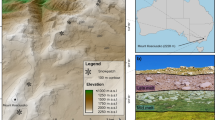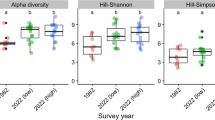Abstract
Alpine snowpatches are areas that, due to topographical and climatic factors, retain snow long after the thaw in the surrounding landscape. Within snowpatches there are often reliable patterns of snowmelt resulting in differences in plant composition, with snowpatch specialists limited to areas of late snowmelt. In 2013, we resurveyed vegetation in early, mid and late snowmelt zones across seven alpine snowpatches in the Snowy Mountains, Australia, 6 years after the initial 2007 survey. In both surveys, there were differences in vegetation cover and species composition among snowmelt zones; in particular, the cover of graminoids was higher in areas of earlier thaw. Differences in functional composition between survey periods were determined using functional traits (plant height, percent leaf dry matter content and specific leaf area) to calculate community trait-weighted means. In both surveys, early and mid snowmelt zones were dominated by taller species with larger leaves, mostly graminoids. Notably, by 2013 there was an increase in species richness in the late snowmelt zone and an increase in the cover of the tall tussock grass Poa costiniana across all snowmelt zones, driving changes in the community trait-weighted means for plant height and specific leaf area in the late snowmelt zone. The results highlight that snowpatch vegetation can change within relatively short time periods and that snowpatch plant communities may not remain as discrete units in the near future due to the encroachment of more competitive and productive species from the surrounding landscape.






Similar content being viewed by others
References
Beniston M (2003) Climate change in mountain regions: a review of possible impacts. Clim Change 59:5–31
Björk RG, Molau U (2007) Ecology of alpine snowbeds and the impact of global change. Arct Antarct Alp Res 39:34–43
BOM (2013) Bureau of Meteorology, Australian Government Accessed from http://www.gov.au/climate/current/season/nsw/archive/201302.summary.shtml Accessed 27 Dec 2013
Canaday BB, Fonda RW (1974) The influence of subalpine snowbanks on vegetation pattern, production and phenology. Bull Torrey Bot Club 101:340–350
Carbognani M, Petraglia A, Tomaselli M (2012) Influence of snowmelt time on species richness, density and production in a late snowbed community. Acta Oecol 43:113–120
Carbognani M, Petraglia A, Tomaselli M (2014) Warming effects and plant trail control on the early-decomposition in alpine snowbeds. Plant Soil 376:277–290
Clarke KR (1993) Non-parametric multivariate analyses of changes in community structure. Aust J Ecol 18:117–143
Cornelissen JHC, Lavorel S, Garnier E, Diaz S, Buchmann N, Gurvich DE, Reich PB, ter Steege H, Morgan HD, van der Heijden MGA, Pausas JG, Poorter H (2003) A handbook of protocols for standardised and easy measurement of plant functional traits worldwide. Aust J Bot 51:335–380
Costin AB (1954) A study of the ecosystems of the Monaro Region of New South Wales. Government Printer, Sydney
Costin AB, Gray M, Totterdell CJ, Wimbush DJ (2000) Kosciuszko Alpine Flora. Collins, Melbourne
Davis CJ (2013) Towards the development of long term winter records for the Snowy Mountains. Aust Mete Oceanogr J 63:303–313
Díaz S, Cabido M (2001) Vive la difference: plant functional diversity matters to ecosystem processes. Trends Ecol Evol 16:646–655
Galen C, Stanton ML (1995) Responses of snowbed plant species to changes in growing-season length. Ecology 76:1546–1557
Gottfried M, Pauli H, Futschik A, Akhalkatsi M, Barancok P, Benito Alonso JL, Coldea G, Dick J, Erschbamer B, Fernández Calzado MR, Kazakis G, Krajci J, Larsson P, Mallaun M, Michelsen O, Moiseev D, Moiseev P, Molau U, Merzouki A, Nagy L, Nakhutsrishvili G, Pedersen B, Pelino G, Puscas M, Rossi G, Stanisci A, Theurillat J-P, Thomaselli M, Villar L, Vittoz P, Vogiatzakis I, Grabherr G (2012) Continent-wide response of mountain vegetation to climate change. Nat Clim Change 2:111–115
Grabherr G, Gottfried M, Pauli H (1994) Climate effects on mountain plants. Nature 369:448
Green K, Osborne WS (1994) Wildlife of the Australian Snow Country. Reed, Sydney
Green K, Pickering CM (2009a) The decline of snowpatches in the Snowy Mountains of Australia: importance of climate warming, variable snow and wind. Arct Antarc Alp Res 41:212–218
Green K, Pickering CM (2009b) Vegetation, microclimate and soils associated with the latest-lying snowpatches in Australia. Plant Ecol Divers 2:289–300
Hennessy KL, Whetton PH, Walsh K, Smith IN, Bathols JM, Hutchinson M, Sharples J (2008) Climate change effects on snow conditions in mainland Australia and adaptation at ski resorts through snow making. Climat Res 35:255–270
IPCC (Intergovernmental Panel on Climate Change) (2014) Climate change 2014: impacts, adaptation and vulnerability. Contribution of Working Group II to the Fifth Assessment Report of the Intergovernmental Panel on Climate Change. Cambridge University Press, Cambridge
Kameyama Y, Kudo G (2009) Flowering phenology influences seed production and outcrossing rate in populations of an alpine snowbed shrub, Phyllodoce aleutica: effects of pollinators and self-incompatibility. Ann Bot 103:1385–1394
Körner C (2003) Alpine plant life, 2nd edn. Springer, Berlin
Körner C, Paulsen J (2004) A world-wide study of high altitude treeline temperatures. J Biogeo 31:713–732
Kudo G, Ito K (1992) Plant distribution in relation to the length of the growing season in a snow-bed in the Taisetsu Mountains, northern Japan. Vegetation 98:165–174
Lepš J, de Bello F (2008) Macro for calculation of functional diversity. University of South Bohemia, Czech Republic. http://botanika.bf.jcu.cz/suspa.FunctDiv.php. Accessed 14 Jul 2009
Lepš J, de Bello F, Lavorel S, Berman S (2006) Quantifying and interpreting functional diversity of natural communities: practical considerations matter. Preslia 78:481–501
Mason NWH, MacGillivray K, Steel JB, Wilson JB (2003) An index of functional diversity. J Veg Sci 14:571–578
Mason NWH, Mouillot D, Lee WG, Wilson JB (2005) Functional richness, functional evenness and functional divergence: the primary components of functional diversity. Oikos 111:112–118
McGill BJ, Enquist BJ, Weiher E, Westoby M (2006) Rebuilding community ecology from functional traits. Trends Ecol Evol 21:178–185
Pauli H, Gottfried M, Reiter K, Klettner C, Grabherr G (2007) Signals of range expansion and contractions of vascular plants in the high Alps: observations (1994-2004) at the GLORIA master site Schrankogel, Tyrol, Austria. Global Change Biol 13:147–156
Pauli H, Gottfried M, Dullinger S, Abdaladze O, Akhalkatsi M, Alonso JLB, Coldea G, Dick J, Erschbamer B, Fernandez Calzado R, Goshn D, Holten JI, Kanka R, Kazakis G, Kollár J, Larsson P, Moiseev P, Moiseev D, Molau U, Molero Mesa J, Nagy L, Pelino G, Puscas M, Rossi G, Stanisci A, Syverhuset AO, Theurillat J-P, Thomaselli M, Unterluggauer P, Villar L, Vittoz P, Grabherr G (2012) Recent plant diversity changes on Europe’s mountain summits. Science 336:353–355
Petchey OL, Gaston KJ (2006) Functional diversity: back to basics and looking forward. Ecol Lett 9:741–758
Rumpf SB, Semenchuk PR, Dullinger S, Cooper EJ (2014) Idiosyncratic responses of high arctic plants to changing snow regimes. Plos One 0086281
Schöb C, Kammer PM, Choler P, Veit H (2009) Small-scale plant species distribution in snowbeds and its sensitivity to climate change. Plant Ecol 200:91–104
Stanton ML, Rejmánek M, Galen C (1994) Changes in vegetation and soil fertility along a predictable snowmelt gradient in the Mosquito range, Colorado, USA. Arct Antarc Alp Res 26:364–374
Venn SE, Morgan JW (2007) Phytomass and phenology of three alpine snowpatch species across a natural snowmelt gradient. Aust J Bot 55:450–456
Venn SE, Morgan JW (2009) Patterns in alpine seedling emergence and establishment across a stress gradient of mountain summits in south-eastern Australia. Plant Eco Divers 2:5–16
Venn SE, Green K, Pickering CM, Morgan JW (2011) Using plant functional traits to explain community composition across a strong environmental filter in Australian alpine snowpatches. Plant Eco 212:1491–1499
Venn SE, Pickering CM, Green K (2012) Short-term variation in species richness across an altitudinal gradient of alpine summits. Biodivers Con 21:3157–3186
Venn SE, Pickering CM, Green K (2014) Spatial and temporal functional change in alpine summit vegetation is driven by increases in shrubs and graminoids. AoB PLANTS 6:plu008
Villeger S, Mason NWH, Mouillot D (2008) New multidimensional functional diversity indices for a multifaceted framework in functional ecology. Ecology 89:2290–2301
Westoby M (1998) A leaf-height-seed (LHS) plant ecology strategy scheme. Plant Soil 199:213–227
Wimbush DJ, Costin AB (1973) Vegetation mapping in relation to ecological interpretation and management in the Kosciusko alpine area. CSIRO, Melbourne
Acknowledgments
This work was supported financially by the Australian Government and the partners in the National Climate Change Adaptation Research Facility (NCCARF) consortium. The views expressed herein are not necessarily the views of the Commonwealth of Australia, and the Commonwealth does not accept responsibility for any information or advice contained herein. Mark Ballantyne and Sebastian Rossi assisted with fieldwork in 2013. Clare Morrison commented on an early version of the manuscript, and Michael Arthur provided statistical advice on generalized linear mixed models.
Author information
Authors and Affiliations
Corresponding author
Additional information
This article is part of the special issue Vegetation in cold environments under climate change.
Electronic supplementary material
Below is the link to the electronic supplementary material.
Rights and permissions
About this article
Cite this article
Pickering, C., Green, K., Barros, A.A. et al. A resurvey of late-lying snowpatches reveals changes in both species and functional composition across snowmelt zones. Alp Botany 124, 93–103 (2014). https://doi.org/10.1007/s00035-014-0140-0
Received:
Accepted:
Published:
Issue Date:
DOI: https://doi.org/10.1007/s00035-014-0140-0




